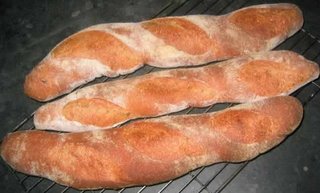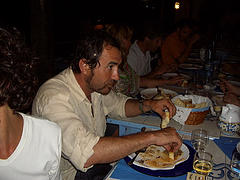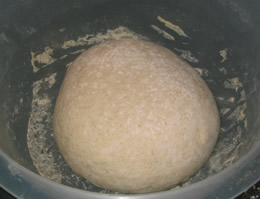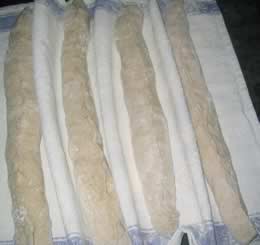Italian poor man’s bread - Il Filone and the forbidden Scarpetta
written by David Anderson limited rights reserved ViewItaly.blogspot.com
 It is customary to place bread directly on the tablecloth at the dinner table. Several micchette, rosette and a long loaf of bread, the filone, strategically placed across between the plates. As the hostess serves the individual servings each individual will choose the bread he wishes. Bread, a primary stable, is often purchased twice a day, fresh and hot from the bakery and never cut into pieces.
It is customary to place bread directly on the tablecloth at the dinner table. Several micchette, rosette and a long loaf of bread, the filone, strategically placed across between the plates. As the hostess serves the individual servings each individual will choose the bread he wishes. Bread, a primary stable, is often purchased twice a day, fresh and hot from the bakery and never cut into pieces. The filone, known as the poor man’s bread, is a long tube of bread, shorter than a baguette, but very similar in both texture and utilization. It is the everyday bread, probably one of the first breads as evidenced by the development of the grissino. It is flavorful and soft with a thin and savory crust. The filone is the perfect bread for the scarpetta. Scarpetta, highly frowned upon in formal dining, is sopping up the remaining sauce with a piece of bread. Should the temptation be to great, the sauce is so inviting, break a piece of bread and use the fork to execute the Scarpetta. Often, if I were dining late in the evening after others had retired for the night, I would warm some left over sauce and break off a piece of the filone, spreading the sauce or dipping the bread, I would be in hog’s heaven.
The filone, known as the poor man’s bread, is a long tube of bread, shorter than a baguette, but very similar in both texture and utilization. It is the everyday bread, probably one of the first breads as evidenced by the development of the grissino. It is flavorful and soft with a thin and savory crust. The filone is the perfect bread for the scarpetta. Scarpetta, highly frowned upon in formal dining, is sopping up the remaining sauce with a piece of bread. Should the temptation be to great, the sauce is so inviting, break a piece of bread and use the fork to execute the Scarpetta. Often, if I were dining late in the evening after others had retired for the night, I would warm some left over sauce and break off a piece of the filone, spreading the sauce or dipping the bread, I would be in hog’s heaven.Simple to make, it is a great solution in any occasion. Patience and forethought is the key.
Ingredients for 3 filoni:
1 ½ cup (150 gr.) Biga
1 tablespoon sugar
1 ¼ cup water – room temperature
1 package (7 gr.) active dry yeast
3 ¾ cups unbleached all-purpose flour
1 tablespoon gluten (if available mix with flour)
2 teaspoons salt
Preparation:
 Dissolve the sugar in the water and then stir in the yeast. Let stand for 10 minutes until creamy.
Dissolve the sugar in the water and then stir in the yeast. Let stand for 10 minutes until creamy.Place the Biga in a mixing bowl. Add the yeast mixture to the Biga and stir together for about 3 minutes.
Add the flour-gluten-salt and stir together. Knead on a floured surface until the dough is firm and not sticky.
Place in an oiled bowl, cover with plastic wrap and a towel. Place in the refrigerator for 24 hours.
Shaping and second rise:
 Place dough on a floured surface and cut into three pieces. Flatten the dough and then roll, from back to front, the dough into a log. Tuck the ends of the dough and place on a kitchen towel to rise. Cover with plastic wrap and a towel and let rise for one hour.
Place dough on a floured surface and cut into three pieces. Flatten the dough and then roll, from back to front, the dough into a log. Tuck the ends of the dough and place on a kitchen towel to rise. Cover with plastic wrap and a towel and let rise for one hour.Baking:
Preheat the oven to 500 degrees. Once at temperature reduce to 450. Carefully place the logs onto the baking sheet. Cut long diagonal incisions along the top about ¼ inch deep. Spray the sides of the oven with water. Be careful, steam will exit the oven and it is very hot. Finally place the logs in the oven and spray the dough with water. During the first 10 minutes spray the dough 3 more times.
Bake for 25-27 minutes until the crust is deep golden brown. Cool on a rack.
Tags: Filone Bread Italian Bread Italian Recipes Food and Wine Travel Italy
Labels: Gourmet Foods, Italian Bread, Italian Recipes



4 Comments:
i must be a real cafona 'cuz we shaw do be doin' the scarpetta 'round here...
3:11 PM
tracie b. - That tells me that the cuoca is really good. I confess that even with risotto I have to have my bread to clean the plate.
3:23 PM
I love 'fare la scarpetta' - I can't eat pasta without bread. When my Italian family came to stay with us a few years ago my Uncle insisted on having bread with everything. And I mean everything.
6:57 AM
A true Italian!
Last night Raffaella made Risotto al Barolo with Salsiccia. She laughed as I mopped up the residuals off of my plate, her plate and the pot.
7:37 AM
Post a Comment
<< Home